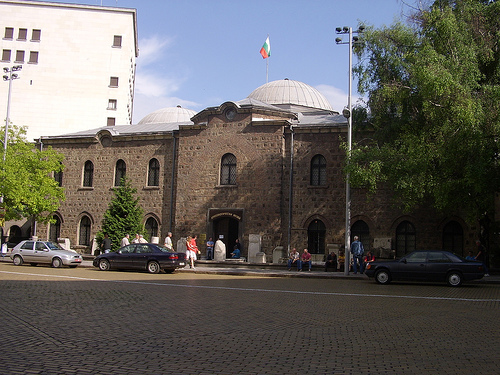

Archaeological museum is a former mosque called Buyuk Djami (Great Mosque), named so since this was the largest and most important mosque of Sofia. It was build in 1474 during rule of Mehmed II and in the state of very good preservation. In the late 19th century the mosque was turned into a war hospital for wounded Bulgarian and Russian soldiers. Later it was turned into library, printing centre and finally today's archaeological museum. The museum has five halls: Central, Prehistory, Middle Ages, Treasure and a special hall for temporary exhibition. With 7000 years of existence Serdica- Sredets- Sofia has a lot to offer.
History of the Museum Building
NAIM-BAS is the
former Buyuk (big) mosque of the 15th century saved by the Bulgarian
state from self-destruction. Her name was "Koja Mahmud Pasha Jamisi"
(The Mosque of the Great Mahmud Pasha) - the Grand vizier of Sultan
Murad II (1421 - 1451), who in 1451 became the Bumblebee of Rumelia
(European possessions of the Ottomans), relocates the main their
city from Edirne in Sofia and the same year commissioned the
construction of the mosque, was built for 43 years and completed
twenty years after his death in 1494. It is architecturally of the
type isopolycopoly mosques, its domes are 9 low sector. The
liberation of Sofia from the Russians welds it with a fallen
minaret, long destroyed and abandoned.
When Metropolitan
Clement is Prime Minister, the Tear and Laugh troupe wants her to
make her theater there, the Metropolitan refuses to say, "I am from
the temple, even if it was Mohammed, I am not a punisher!" And it
was given to the Public Library, officially opened in 1880 and moved
thereafter in 1885. It is a museum collection that has become a
museum department. Between 1900 and 1905, the Archaeological Museum
was finally established in the renovated building. In 1938 - 1940, a
new building was created, which housed the National Bank, however,
and two floors were erected for the museum in two of its wings,
connected to the former mosque, which had been rebuilt. The ancient
building with the museum's exposure was hit by the Anglo-American
bombing of Sofia in 1944 and it reopened only in 1948. Full
renovation began 45 years later in 1993-1994, the last stage of
which took place in 2003 - 2005
Currently, the Sofia
Archaeological Museum holds one of the richest archeological
collections on the Balkan Peninsula. The site is the 3rd oldest
preserved to cornice century-old building of Sofia after its
opposite Rotunda St. George and St. Sofia Cathedral, except for the
small medieval churches around the city. Archaeological excavations
have uncovered cultural layers from several epochs.
Structure
of the Institute
As of 2012, NAIM-BAS includes the following
units and laboratory for analysis, conservation and restoration:
Scientific units
Prehistoric section
Thracian Archeology
Section
Section for Ancient Archeology
Section for Medieval
Archeology
Section for numismatics and epigraphy
Problem group
for interdisciplinary research
Branch in Shumen
Branch in
Veliko Tarnovo
Archaeological Museum
Exposure department
Funds Division
Specialized units
Part of the specialized
units are:
Editorial and publishing group
Scientific Archive
Administrative units
History of the Institute
Archaeological
Museum until 1948
The Archaeological Museum was established
in 1892, when the Department of Values was established in 1879 and
separated from the structure of the National Library. Initially, the
museum was called the People's Museum and included 3 collections -
Starovekovna, Numismatic and Ethnographic. The museum is housed in
the building of the Buyuk Mosque in Sofia, where it is still located
today. The museum was solemnly opened to the public on May 18, 1905
personally by Prince Ferdinand I and the Minister of Enlightenment,
Dr. Ivan Shishmanov. In 1906 the ethnographic collection was
separated into the present-day Ethnographic Institute with a museum.
In 1909, the museum was renamed the National Archaeological
Museum, entrusted with the preservation of cultural monuments and
two new departments were set up - the Medieval and the Artistic. In
1911, the Prehistoric Department was established. In 1921, the
exposition was largely reconstructed, and from 1928 temporary
thematic exhibitions began to be organized. In the late 1930s, two
wings were erected by the BNB for administrative purposes and the
exposition was rebuilt, leaving only the more interesting sites.
The museum building was partially affected by the
British-American bombing in the winter of 1944, when part of the
library and museum records were burned. In 1948, the Art Department
was separated from the museum and the present-day National Art
Gallery was created, and another part of the icon collection was
transferred to the Crypt in the 1960s.